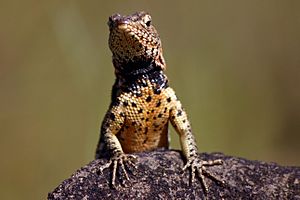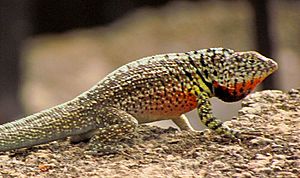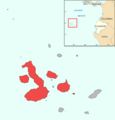Albemarle Lava lizard facts for kids
Quick facts for kids Albemarle Lava lizard |
|
|---|---|
 |
|
| Female, Santa Fe Island | |
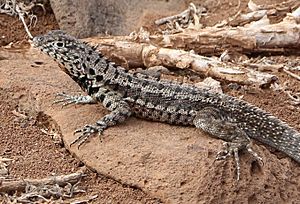 |
|
| Male, Isabela Island | |
| Conservation status | |
| Scientific classification | |
| Genus: |
Microlophus
|
| Species: |
albemarlensis
|
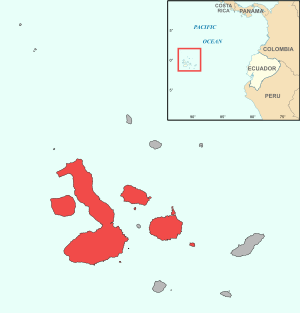 |
|
| Range (red) in the Galápagos Islands | |
| Synonyms | |
|
|
The Galápagos Lava Lizard, also called the Albemarle Lava Lizard, is a type of Lava Lizard. Its scientific name is Microlophus albemarlensis. These lizards live only on the Galápagos Islands. You can find them on several large islands like Isabela, Santa Cruz, Fernandina, Santiago, and Santa Fe. They also live on smaller islands such as Seymour, Baltra, Plaza Sur, Daphne Major, and Rábida.
This lizard is the most common type of Lava Lizard found across the Galápagos. Other kinds of Galápagos Lava Lizards usually live on just one island. Some scientists think that the lizards on Santiago, Santa Cruz, and Santa Fe islands might be different species. The Galápagos Lava Lizard is part of the Microlophus group. Long ago, it was placed in the Tropidurus group.
Contents
What They Look Like
Galápagos Lava Lizards are usually small. They are about 4 to 7 inches (10 to 18 cm) long. Males are often bigger, around 6 to 7 inches (15 to 18 cm). Females are 4 to 7 inches (10 to 18 cm) long. Some have even been seen growing up to a foot (30 cm) long! Their tail is often as long as or even longer than their body.
These lizards have slim bodies and pointed heads. Their colors can change depending on if they are male or female. Males often have brighter colors, like yellow and gold stripes. Females usually have a red mark on their throat and head. The place they live also affects their appearance.
Lava lizards can drop their tails if a predator grabs them. This helps them escape danger. Their tails can grow back, but they are usually not as long as the original tail.
Where They Live
The Galápagos Lava Lizard lives on the Galápagos Islands. These islands are a group of islands in the Eastern Pacific Ocean. They were formed by volcanoes and lava. The islands are located on both sides of the equator. This means the lava lizard lives in both the Northern and Southern Hemispheres.
The climate on these islands is warm and dry. This makes it a great place for these lizards to live. Each island might have a slightly different type of lava lizard. Their homes need places to hide from the sun. They also need dry leaves and rocks. This allows them to sunbathe and hide. They like dry, low areas with loose soil and dry leaf litter. This lets them bury themselves to stay cool at night. They also need enough food nearby. This includes plants, seeds, arthropods, and flowers.
What They Eat
Galápagos Lava Lizards eat mostly insects, spiders, and other small creatures. They commonly eat maggots (fly babies), ants, and beetles. If they live near people, they might also eat bread crumbs or meat scraps. Sometimes, they eat parts of leaves and flowers. They have also been seen eating large seeds. Lizards have even been seen in trees eating fresh leaves. These leaves were as high as 7 feet (2.1 meters) off the ground!
Lava lizards are considered omnivores, meaning they eat both plants and animals. But they mostly eat insects. They help control insect populations on the islands. They are an important part of the Galápagos food chain. Most of the time, they wait still for insects to come by. But some lizards dig for insect larvae under the ground. They use their heads and front legs to move the soil. During dry times, they might eat each other, or more plants and seeds. What they eat can also depend on their size. Bigger lizards tend to eat more plants.
Sometimes, lava lizards sit on the tails of marine iguanas. They do this to eat insects that are attracted to the iguanas. This is a special kind of helpful relationship.
How They Act
Reproduction
Male Galápagos Lava Lizards often mate with females in their area. A male's territory can be quite large. To show off and scare away other males, they do a special "push-up" display. This makes them look bigger and stronger. If another male feels brave, they might have a push-up contest. This contest continues until one lizard gives up. Sometimes, they might even bite or slap tails if the fight lasts too long.
After a male wins, he can mate with a female. They usually breed during the warm season, from November to March. Females lay about four small eggs in a burrow. The eggs hatch after about 3 months. Baby lizards are usually about 1 to 1.5 inches (3 to 4 cm) long. They are very small and can be easily caught by birds.
Females grow up faster than males. Females can be ready to mate as early as nine months old. Males take longer, maturing after about three years. It is hard to tell males and females apart before they become adults.
Daily Life and Being Territorial
Galápagos Lava Lizards are active during the day. They come out around sunrise. They hide during the hottest part of the day, usually around midday. Then they become active again in the afternoon. At night, they dig into the soil or leaf litter. They often return to the same spot to sleep each night.
These lizards are very territorial. They are known for being aggressive towards other lava lizards. They often do their push-up displays in public areas to warn off other lizards. Head bobbing movements also help scare away other males. If these displays do not work, they might bite or slap tails. They try to look as big and strong as possible.
Lava lizards can also change their color. This helps them blend in with their surroundings. Their color can also change based on the temperature or even their mood. The color of a lava lizard also depends on where it lives. These lizards can live for up to 10 years, which is a long time for a reptile. They do not make sounds to talk to each other. Instead, they use visual displays.
Scientists are studying if lava lizards help spread pollen between plants. This behavior has been seen in some lizards. More studies are needed to understand how much they help with pollination.
Lizards and Humans
Lava lizards are active all year round, mostly during the day. They are cold-blooded animals that eat plants and insects. They usually do not interact with humans. Sometimes, they might eat food scraps left by people. Lava lizards are not dangerous to humans. Their bite is not harmful, and they are not known to bite people. Their aggression is mostly towards each other. They fight over territory and mates.
Lava lizards can be kept as pets. They are also useful for studying how animals change over time. Scientists believe that the seven types of lava lizards came from one common ancestor. As pets, they are safe. They are fed their usual diet and kept in warm conditions. This is important because they are cold-blooded animals.
Conservation
Lava lizards have natural enemies. These include snakes, scorpions, hawks, and herons. Sometimes, they even eat each other! Their main way to defend themselves is by dropping their tail. The tail keeps moving, which distracts the predator. This gives the lizard time to hide or run away.
Currently, Galápagos Lava Lizards are not in immediate danger. However, global warming and humans destroying their homes could change this. People who live in areas with lava lizards should be careful with their pets. They should also be aware of how human actions affect nature.
A study looked at how cars hitting wildlife affects lava lizards. Lava lizards often live near roads. The study wanted to help protect them, especially as more roads are planned. It found that lizard populations were higher further away from roads. About 100 meters (330 feet) from a road, there were 30% more lizards. The study also looked at lizards killed by cars. It found that 71% of these lizards had lost their tails. This shows that modern development can harm many species.
Climate change is also a big threat to lava lizards. It is important for people to learn about how their actions affect the environment. These effects can be different in various places around the world.
See also
- Galápagos wildlife
Images for kids



